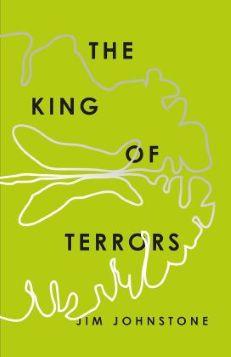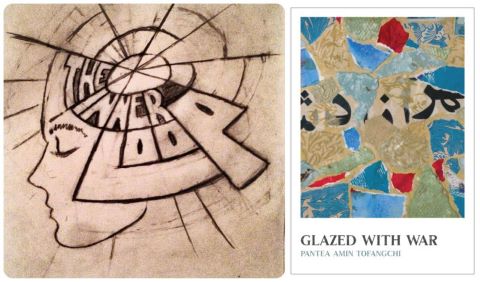On Jim Johnstone’s The King of Terrors.

Every year, I stand at the front of various Southeastern Ontario university classrooms and deliver a lecture to medical students titled “Metaphor and Medicine.” I’m invited because I’m a poet, physician, and literary scholar — not “just” someone who makes metaphors, nor someone who studies them, but one who also has an applied knowledge of them.
We start with conventional representations (e.g., poems that identify states of illness as a “battle” or “struggle” connected with the martial metaphor system, or mechanically inclined poems that liken the circulatory system to a “pump” with “tubes” and “pipes”). Poems like these reveal the dead metaphoric workings of students’ thinking, enabling them to see that the metaphors they unconsciously use structure their thought, with possibly negative consequences.
For the remainder of the talk, we work through poems that metaphorize illness in relatively productive ways (for instance, ones that theorize the body as an open system or an ecology). We discuss why thinking of the body in such a way is more holistic and realistic. We never get far in this work, for an hour is but an hour. Only the rarest student identifies an aspect of a poem’s form that contributes to illness construction. For most, metaphor is the practical instrument they can grasp easiest, for they’ve been using it all their lives, albeit unconsciously.
Metaphor is from the Greek metapherein, “to carry across” or “to transfer.” Metaphors are concrete instances of bringing one thing into relation to another, of attempting to bridge a gap of understanding by way of comparison. When compared with formal analysis, a metaphor-based assessment is easy, but it’s an appreciation of form that allows a doctor to grasp not only the meanings of a patient’s speech but the additionally meaningful, informing context around that speech.
To demonstrate this to students, I bring forward two formally consistent poems from Jim Johnstone’s seventh collection, The King of Terrors (Coach House Books, 2023). The book concerns the diagnosis and surgical resection of a meningioma in his brain and is not a tale but a series of oblique poetic passes. I show students how Johnstone formally deploys affect (fear) on the page, and I begin with a discussion of the title poem, which provides a visual representation of terror:
First there was fear. Fear of being shut in, a continent of shut-ins, shut up.
Fear without breath.
Fear of continental drift, the advance of the recently landed.
Fear hovering between two ways —
alveoli
deflated like punctured balloons.Fear of the body, the body bag, bodies zipped and dragged from home.
Fear leading by example
Fear untouched, unchanged.
The first thing to note is that the poem has an anaphoric structure. Each full sentence or semantic unit includes a definition of fear. The fear is not disembodied, as it often can be in anxiety, but rather embodied. Johnstone’s serial representations insist on an either/or bodily tether. Either fear is riffed on initially in terms of the containment of bodies during the pandemic (“Fear of being shut in, a continent of shut-ins, shut up”) or it returns as a literal fear of bodies (“Fear of the body, the body bag, bodies zipped and dragged from home”). Embodied fear comes when Johnstone creates organic imagery for fear (“alveoli / deflated like punctured balloons”) that does double-duty as metaphor.
I encourage the students to think of how anaphoric productions they might already know — such as Allen Ginsberg’s “Howl” — typically are intended to be performed aloud. In such works, repetition creates its own momentum. I also point out how Johnstone places his lines as if they’re falling down the page, thrown in an alternating fashion toward the right margin (by a deep breath, perhaps). Several poems in the collection repeat this technique of falling lines that enact fear while also somehow being about fear. What’s particularly fearsome about them is their control, one maintained despite the intensity of the feeling represented.
Next, we consider together the first movement of “There Is Nothing More Invasive than Snow”:
falling in a temple
A tumour lodged so what’s witnessed
is memory,Second
tenseA separate mind
I’m mindful to claim this gift without
unwrapping it.Life
as death.Sentence
A scaffold
where pain steadies until its blade
slices down.Tent pole.
Brain bound.
Metaphoric thinking abounds here (hospital as “temple,” life as a “scaffold,” tumor as a memory-bearing “you,” pain as both “blade” and “tent pole”). Students catch on to these quickly. I challenge them to consider the blank lines separating entries and the resultant feeling of falling, often deliberately intensified by fracturing indented lines so that they literally fall on top of one another. Another valence is added when the sense of the poem itself indicates a downward directionality (“falling” and “slices down”). When Johnstone end-stops “death” but then quasi-enjambs it with the single-word line “Sentence,” one understands that this poet’s life-threatening illness requires expression in a concretized form.
But even in this formal container, the poems live and express their experience, held under a fearful pressure that is their container, too. The effect is of an integrated performance: Tonally, the poems convey fear by naming the feeling; sense-wise, they concern a life-threatening illness experienced during a life-threatening pandemic; and formally, they fall down the page like a body in descent.
Speaking professionally, it all feels very familiar, as if the fear I know so well as a physician is again in the room. Which is exactly the point of my lecture to students: Consider the space and predicament your patients are in, not just their symptoms.
Shane Neilson is a disabled physician who will publish What to Feel, How to Feel: Lyric Essays on Neurodivergence & Neurofatherhood with Palimpsest Press in June.

